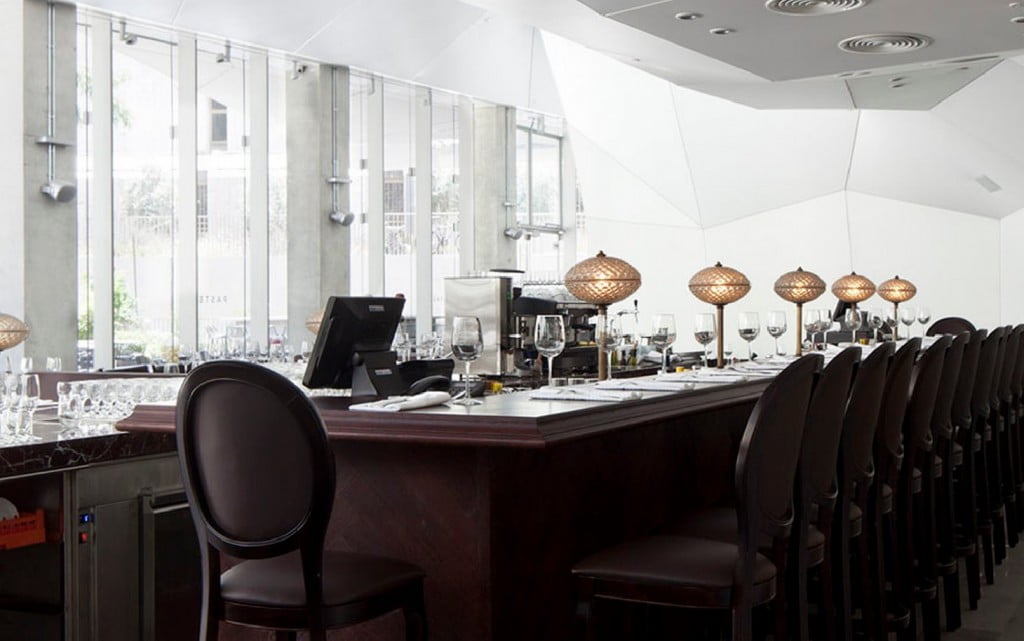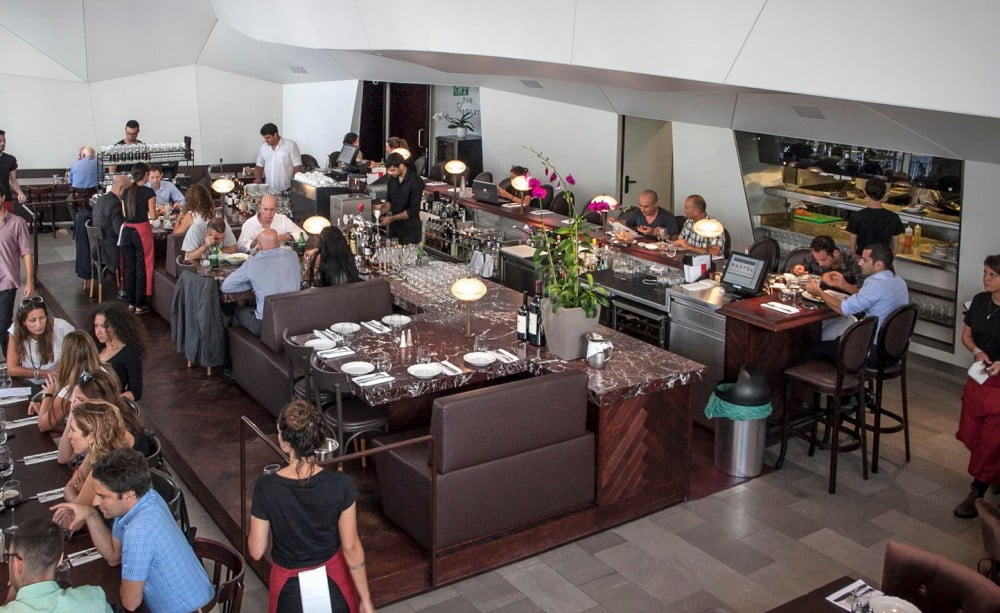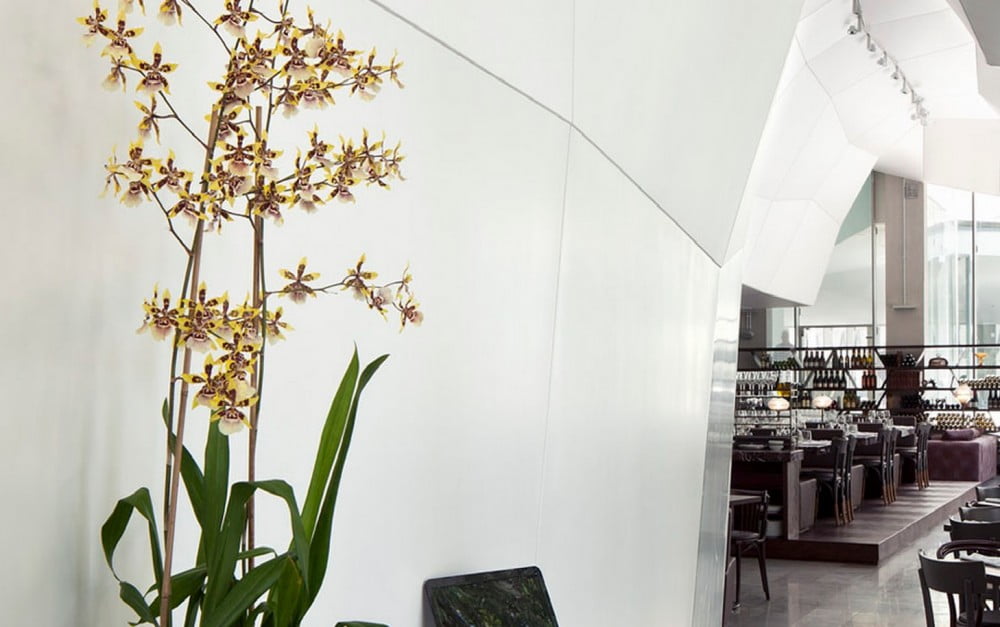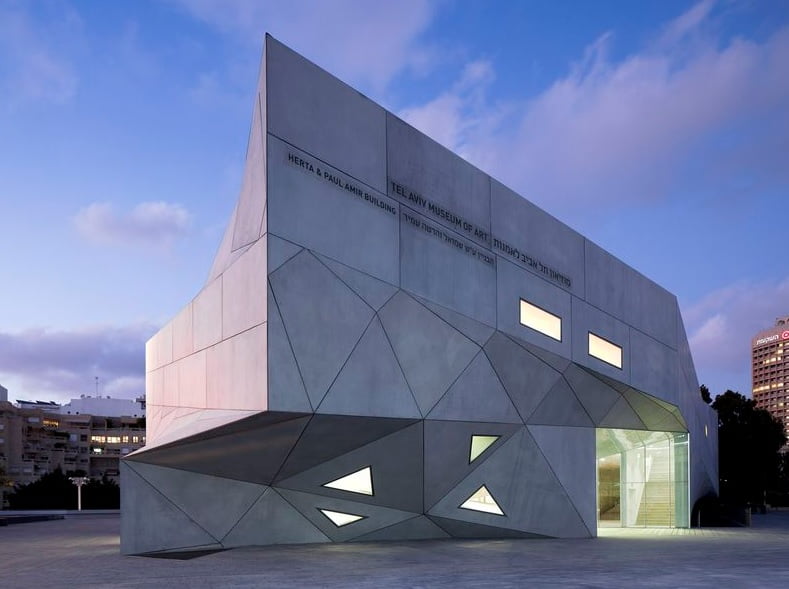The most stunning restaurant on earth is apparently in Tel Aviv, Israel: The Israeli designers of Pastel Brasserie and Bar in the Herta and Paul Amir Building at the Tel Aviv Museum of Art have won the 2014 International Space Design Award–Idea Tops for the world’s best-designed restaurant. Alon Baranowitz and Irene Kronenberg’s entry won among 4,000 projects from 35 countries entered in the competition (in various categories). The global competition was held in China earlier this month.
The building itself was designed by architect Prof. Preston Scott Cohen of the Harvard Graduate School of Design. The interior design of the restaurant was created by architects Baranowitz and Kronenberg. The couple (in business and in life) is known for designing some of the hippest restaurants in Europe. In addition, they recently designed the Wyndham Grand Frankfurt Hotel in Germany.
SEE ALSO: ‘Saveur’ Magazine Votes Tel Aviv ‘Outstanding Culinary Destination’
Baranowitz graduated from the Pratt Institute in 1990. Kronenberg graduated from the Technion – Israel’s Institute of Technology – in 1981. They founded the BK studio in 1999. Last year, they won the Restaurant and Bar Design Award for the Topolopompo restaurant in Tel Aviv for the best-designed restaurant in the Middle East and Africa.
Pastel Brasserie and Bar, which opened in 2013, was designed by BK Architects inside Tel Aviv Museum of Art’s new wing. Its white, sculptural ceiling, combined with the mahogany hues of its countertops and furniture, create a dynamic space. The interior of the restaurant shimmers in bright daylight, and diners seated on the balcony can view the museum’s sculpture garden.
The building’s “envelope” is drawn into the interior of the restaurant, sculpting the seating area and bar, which are richly outfitted with upholstered booths, antique wooden flooring, a deep burgundy-colored bar, multi-hued marble surfaces, and Art Nouveau lighting fixtures made out of crystal and gilded metal.
Inside the restaurant, BK developed a narrative inspired by two opposite worlds: the new world, represented by the hyper-geometric architecture of the new wing, and the old world of the brasserie – a two-centuries-old culinary bastion of the western world. The dynamic envelope of the new wing is sucked into the space to become the interior envelope of Pastel. According to Kronenberg, the new world is represented by the vigorous geometry clouding Pastel with its endless shades of white. The southeast light bounces onto the grey stone flooring and renders the ceiling with a soft appearance. The brasserie world, on the other hand, is reflected by booth seating, crystal chandeliers, voluptuous marble tops and vintage chairs.
Sign up for our free weekly newsletter
SubscribeThe new wing: $45 million, 430 cement panels
After winning the 2004 Herta and Paul Amir Competition, Cohen designed a new building for the Tel Aviv Museum of Art, with a budget of $45 million. The new wing, which opened in 2011, dominates roughly 19,000 square meters and is known for its hyperboloid form. The building’s exterior envelope, an extended “folding” surface that breaks at certain angles, is a dynamic ornament made of 430 polished cement panels manufactured on location.
“We tried to keep the design of the restaurant within the contextual scenery of the iconic new wing,” Baranowitz tells NoCamels. “We felt very lucky to work inside Cohen’s building, and we incorporated the language of its exterior in the interior.”
Prior to designing Pastel, Baranowitz and Kronenberg researched both French brasseries and museum restaurants around the globe. “We have to be respectful of whatever is in the museum,” he says. “In the Whitney Museum or the Museum of Modern Art, you can really see how the language of the museum finds itself inside the restaurant.”
“Design is everything”
Interior design for Pastel cost roughly $2 million, and its façade is in line with its surrounding, high-end area. Similar to the Lincoln Center in New York, the restaurant’s piazza is also home to the Israeli Opera, the Cameri Theater and the Tel Aviv Museum of Art. While Baranowitz agrees this area may be intimidating to some people, he hopes the design of the restaurant itself is inviting. “I don’t think the restaurant looks expensive from the outside,” he says. “I don’t find it intimidating. It’s well done, very accurate and sharp-looking.”
The restaurant looks inviting, Baranowitz says, but the surrounding area is “quite austere; it’s not the friendliest space.” He admits that to some extent, “Pastel is within that context.”
In his view, design is key to restaurants’ success. “If the food is shitty but the atmosphere is great, you’ll keep coming,” Baranowitz says. “Food is redundant; the design affects the success of the restaurant. Design is everything today.”
SEE ALSO: Too Beautiful To Eat? Israel Museum’s Restaurant Offers Art-Inspired Dishes
Photos courtesy of: Tel Aviv Museum of Art, Pastel Brasserie and Bar, BK, Preston Scott Cohen, Inc.
Related posts

Rehabilitation Nation: Israeli Innovation On Road To Healing

Israeli High-Tech Sector 'Still Good' Despite Year Of War











Facebook comments